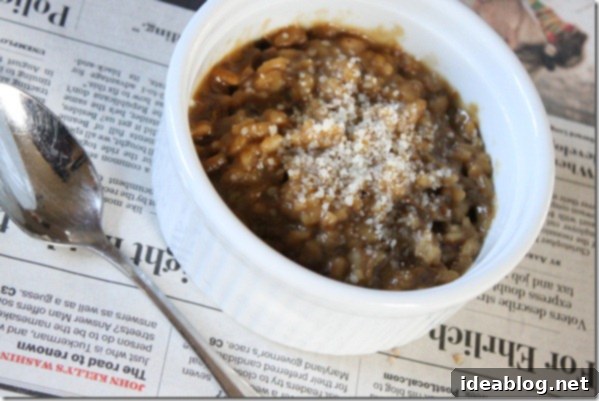Mastering Homemade Porcini Mushroom Risotto: A Creamy & Flavorful Italian Classic
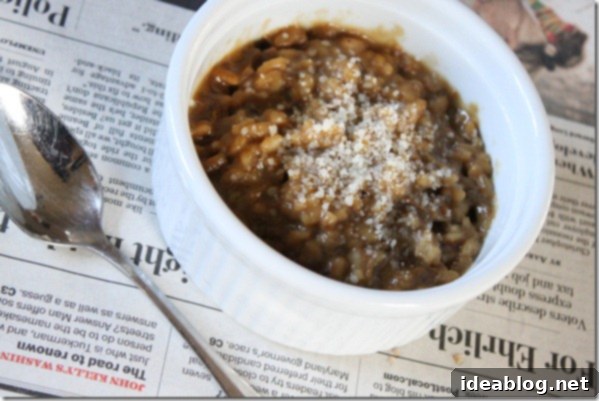
Risotto holds a special place in the hearts of many, revered as one of the ultimate comfort foods. Despite its widespread adoration, the prospect of preparing it at home often feels daunting, an intricate culinary challenge best left to professional chefs. However, this perception couldn’t be further from the truth. Risotto, and particularly a deeply satisfying Porcini Mushroom Risotto, is surprisingly straightforward to master, requiring more patience and intuition than complex techniques or exotic ingredients. It’s a culinary journey that rewards you with an incredibly rich, creamy, and soulful dish, making the effort truly worthwhile.
The Allure of Risotto: A Universal Comfort Food Experience
The beauty of homemade risotto lies in its elegant simplicity and the endless possibilities for customization. Unlike many dishes that demand a precise list of specific ingredients, risotto is forgiving and adaptable. Don’t have any shallots? A regular yellow onion works perfectly. Worried about the cost of gourmet dried wild mushrooms? While porcini offer a unique depth, fresh mushrooms can certainly provide a delightful alternative. Even the primary grain, Arborio rice, can be substituted with alternatives like farro or quinoa for a different texture and nutritional profile, demonstrating risotto’s incredible versatility. This adaptability makes it an ideal dish for home cooks to experiment with, building confidence with each batch.
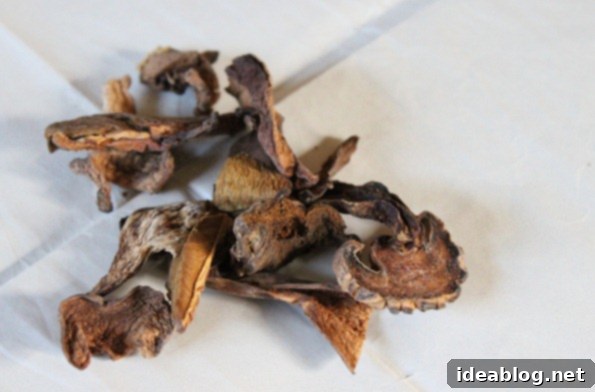
Unlocking Deep Flavor with Dried Porcini Mushrooms
While fresh mushrooms are wonderful, dried porcini mushrooms are the secret weapon behind an exceptionally flavorful mushroom risotto. These revered fungi offer an intensely earthy, nutty, and savory umami punch that fresh mushrooms, even the finest varieties, often can’t replicate. The drying process concentrates their flavor, making them incredibly potent. When rehydrated, they not only soften for chopping and inclusion but also yield a rich, dark liquid – a precious “mushroom broth” – that becomes a foundational element of the risotto’s profound taste. This liquid, infused with the essence of porcini, elevates the dish to new heights, creating a luxurious base that permeates every grain of rice. Don’t discard this golden elixir; it’s essential for achieving that restaurant-quality depth.
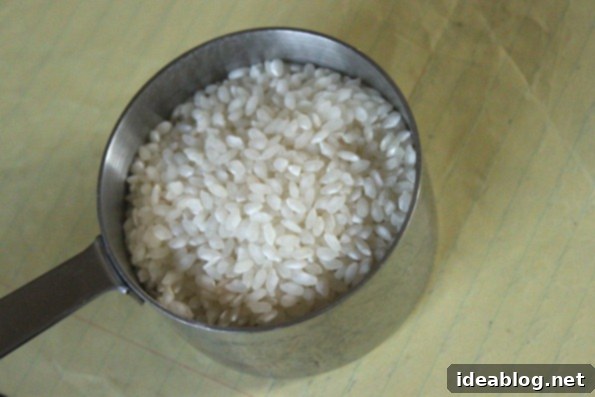
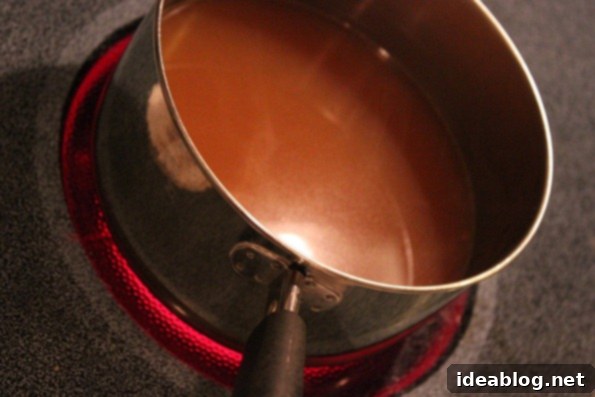
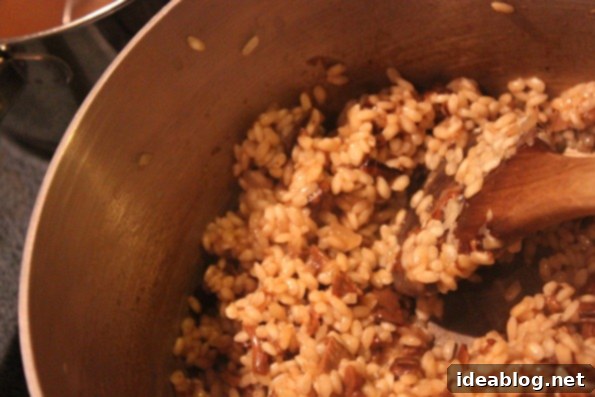
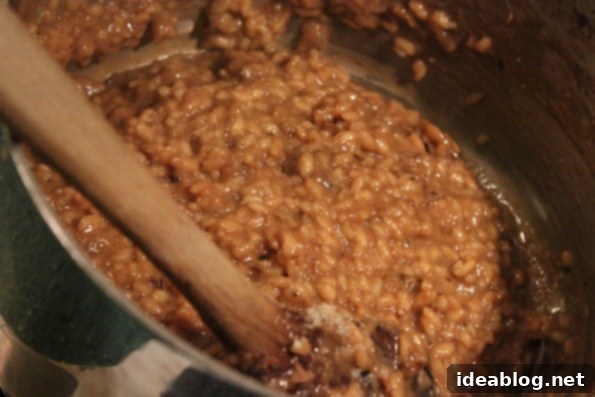
Essential Ingredients for a Perfect Risotto
Crafting the perfect porcini mushroom risotto requires a thoughtful selection of a few key ingredients, each playing a crucial role in achieving that signature creamy texture and robust flavor. The beauty of this dish lies in how these simple components come together to create something truly extraordinary.
The Right Rice: Arborio or Carnaroli
These short to medium-grain Italian varieties are specifically chosen for risotto due to their high starch content, primarily amylopectin. This particular starch is released as the rice cooks and is stirred, resulting in the creamy consistency that defines a good risotto. Unlike long-grain rice, which tends to cook up separately, Arborio and Carnaroli maintain a delightful al dente bite while creating a rich, velvety sauce. Always opt for these specific rice types for authentic results.
The Flavor Foundation: Broth and Aromatics
High-quality chicken or vegetable stock is paramount. It should always be kept warm throughout the cooking process, as adding cold liquid will shock the rice, impeding starch release and affecting the final texture. Our recipe wisely suggests combining regular stock with the reserved porcini soaking liquid, creating an even more complex and savory base. Finely diced yellow onion (or shallots for a milder, sweeter flavor) sautéed in a blend of unsalted butter and extra virgin olive oil forms the aromatic cornerstone, developing sweetness and a deep foundational flavor.
Finishing Touches: Cheese and Seasoning
Freshly grated Parmigiano-Reggiano cheese adds a salty, nutty, and umami finish, contributing significantly to the risotto’s creaminess and flavor. A final knob of cold butter, vigorously stirred in at the very end, provides additional richness and gloss, a technique known as “mantecatura.” Kosher salt and freshly ground black pepper are crucial for seasoning to taste, balancing and enhancing all the flavors, ensuring every bite is perfectly seasoned.
The Art of Risotto Making: A Meditative Culinary Journey
Making risotto is often described as a meditative process. It involves standing over the stove, stirring, and slowly adding liquid, but this hands-on approach is precisely what makes it so rewarding. The continuous, gentle stirring encourages the rice grains to gently rub against each other, releasing their starch and creating that hallmark creamy texture. It’s an act of patience and observation, culminating in a deeply satisfying meal that feels both luxurious and homely.
Porcini Mushroom Risotto Recipe
This mushroom risotto recipe is perfectly scaled for two and gets its incredible depth and punch from dried porcini mushrooms, lending an unmistakable rich flavor that will transport you straight to Italy.
Yield: 2 Servings
Prep time: 10 minutes
Cook time: 30 minutes
Total time: 40 minutes
Ingredients
- ½ cup dried porcini mushrooms
- 3 cups (720 mL) chicken stock (or vegetable stock for a vegetarian option)
- 2 tablespoons unsalted butter, divided
- 1 tablespoon extra virgin olive oil
- ½ yellow onion, very finely diced (or 1-2 shallots)
- 1 cup Arborio or Carnaroli rice
- Freshly ground black pepper, to taste
- Kosher salt, to taste
- ½ cup finely grated Parmigiano-Reggiano cheese
Instructions
- Rehydrate Porcini: Place the dried porcini mushrooms in a bowl and add 2 cups of boiling water, ensuring the mushrooms are just covered. Let the mushrooms hydrate fully for 20 to 30 minutes. Drain the mushrooms with a fine-mesh sieve, making sure to keep and set aside the mushroom liquid for later use.
- Prepare Ingredients: Finely chop the hydrated mushrooms. Set aside. In a separate saucepan, combine the chicken broth and 1 cup of the reserved mushroom broth. Bring this mixture to a low simmer and keep it warm over low heat throughout the cooking process.
- Sauté Aromatics: Place a heavy-bottom pot or Dutch oven over medium heat. Add 1 tablespoon of the unsalted butter and the extra virgin olive oil. Add the finely diced onions and sauté, stirring constantly, until they become very soft and translucent, about 5-7 minutes. Do not let them brown.
- Toast the Rice: With the heat still over medium, add the Arborio rice to the pot and stir the mixture together, ensuring all the rice grains are coated in the fat. Toast the rice for 1 to 2 minutes, stirring constantly, until the edges of the grains appear slightly translucent.
- Begin Adding Broth: Add a ladleful (roughly ½ cup (120mL)) of the simmering stock mixture to the rice. Stir constantly until the liquid has been almost completely absorbed by the rice kernels, and the pot appears nearly dry. Adjust the heat as needed to prevent the liquid from evaporating too quickly or the rice from sticking.
- Continue Cooking: Continue to add broth using the same ladle-by-ladle method, stirring constantly and allowing each addition to be almost fully absorbed before adding the next. This process should take approximately 18-25 minutes. Taste the rice regularly. It is ready when it is al dente – soft on the outside with a slight, pleasant chew in the interior.
- Finish and Serve: Once the rice reaches the desired al dente consistency, remove the pot from the heat. Stir in the chopped porcini mushrooms, the finely grated Parmigiano-Reggiano cheese, and the remaining 1 tablespoon of unsalted butter. Stir vigorously for about 30 seconds to emulsify and create a truly creamy texture (mantecatura). Season to taste with kosher salt and freshly ground black pepper. Serve immediately, as risotto is best enjoyed fresh off the stove.
Tips for a Consistently Creamy Risotto
Achieving that luscious, creamy consistency in your risotto is not just about the right ingredients; it’s about mastering a few key techniques. Here are some pro tips to ensure your porcini mushroom risotto turns out perfectly every time:
- Warm Broth is Key: Always keep your broth simmering gently in a separate saucepan. Adding cold broth to hot rice will shock the temperature of the pot, extending cooking time, slowing starch release, and potentially resulting in a less creamy, unevenly cooked risotto.
- Don’t Rinse the Rice: Unlike cooking regular rice, you absolutely *do not* want to rinse risotto rice. Rinsing would wash away the precious surface starch that is essential for achieving the creamy texture and traditional consistency.
- Toasting the Rice (Tostatura): This initial step is vital. Toasting the dry rice grains in fat until they become slightly translucent around the edges (but not brown) helps to seal the outside of the grain. This allows the inside to cook slowly and evenly while releasing starch, preventing the rice from becoming mushy.
- Add Broth Gradually: Resist the urge to dump all the broth in at once. Adding it ladle by ladle, allowing each addition to be almost fully absorbed before adding the next, is fundamental to the risotto process. This slow and steady approach allows the starch to release gradually and the rice to cook perfectly.
- Stirring is Essential, But Don’t Over-Stir: Frequent, gentle stirring is necessary to release starch and prevent sticking to the bottom of the pot. However, excessive or overly vigorous stirring can incorporate too much air, making the risotto gluey rather than creamy. Find a balanced rhythm.
- Taste for Doneness: The only way to know if your risotto is truly ready is to taste it. It should be al dente – firm to the bite but creamy and tender. There should be a slight, pleasant resistance in the center of the grain.
- The Final “Mantecatura”: This is the crucial finishing step. Removing the risotto from the heat and vigorously stirring in a final knob of cold butter and grated Parmigiano-Reggiano emulsifies the starches and fats. This process gives the risotto its ultimate glossy, velvety richness and irresistible, characteristic creaminess.
Customizing Your Mushroom Risotto
While this recipe highlights the intense flavor of porcini, risotto is a wonderfully adaptable canvas for culinary creativity. Don’t hesitate to personalize your dish:
- Other Mushrooms: Feel free to incorporate other fresh mushrooms alongside or instead of porcini. Sliced cremini, shiitake, oyster, or even wilder varieties like chanterelles can add different textures and aromatic notes. Sauté them separately before adding them towards the end of the cooking process for the best texture and flavor.
- Vegetable Boost: Enhance your risotto with vibrant vegetables. Fresh spinach, tender asparagus tips, sweet peas, or roasted butternut squash can be gently folded into the risotto during the last few minutes of cooking, adding color, nutrients, and additional flavor dimensions.
- Protein Power: For a heartier meal, consider adding cooked proteins. Sautéed chicken breast, succulent shrimp, or flavorful Italian sausage can be cooked separately and stirred into the risotto just before serving, or, for some meats like sausage, cooked with the onions at the beginning to infuse the base with flavor.
- Herbaceous Notes: Fresh herbs like finely chopped parsley, thyme, or rosemary can elevate the aroma and taste profile of your risotto. Stir them in at the very end for maximum freshness and aromatic impact.
- Wine Infusion: A splash of dry white wine (like Pinot Grigio, Sauvignon Blanc, or Vermentino) can be added after toasting the rice (in step 4 of the recipe). Allow it to cook off completely, absorbing into the rice, before you begin adding the broth. This adds a subtle layer of acidity and complexity to the dish.
Serving Suggestions and Wine Pairings
Porcini mushroom risotto is a hearty and satisfying dish that can stand proudly on its own. However, it also pairs beautifully with a simple green salad dressed with a light vinaigrette, which provides a refreshing contrast to the richness of the risotto. A side of crusty artisan bread is always a welcome addition, perfect for soaking up any leftover creamy goodness.
For wine pairings, a dry white wine with good acidity and some body, such as a Gavi, Arneis, or a light Chardonnay (unoaked), would complement the earthy mushroom flavors without overwhelming them. If you prefer red, a light-bodied Pinot Noir or a Barbera can also be a delightful match, offering fruit notes that harmonize with the dish’s savory profile.
Storing and Reheating Leftover Risotto
While risotto is undeniably at its best when served immediately, freshly made, leftovers can be stored in an airtight container in the refrigerator for up to 3-4 days. Reheating risotto can be tricky, as it tends to thicken considerably and lose its characteristic creamy texture. To revive it, gently reheat it in a saucepan over low heat, adding a splash of warm broth or water, and stirring constantly until it regains a creamier consistency. Avoid microwaving, as it can often make the rice gummy and unappetizing.
Nutrition Information (per serving)
(Based on approx. 2 servings of the recipe)
- Serving: 1 serving
- Calories: 396 kcal
- Carbohydrates: 45g
- Protein: 13g
- Fat: 18g
- Saturated Fat: 6g
- Polyunsaturated Fat: 11g
- Cholesterol: 28mg
- Sodium: 898mg
- Fiber: 1g
- Sugar: 8g
Conclusion: Embrace the Risotto Journey
Don’t let the mystique surrounding risotto deter you from trying your hand at this exquisite Italian classic. With a few quality ingredients, a bit of patience, and these straightforward steps, you can confidently create a porcini mushroom risotto that is rich, creamy, and bursting with flavor. It’s a true testament to the power of simple ingredients transformed into something truly extraordinary – a dish that embodies warmth, comfort, and culinary satisfaction. So, grab your wooden spoon, put on some music, and embark on your own risotto journey. The reward is a bowl of pure, unadulterated comfort, awaiting your enjoyment.
Author: Laura / A Beautiful Plate
Course: Pastas, Risottos, and Grains
Cuisine: Italian
